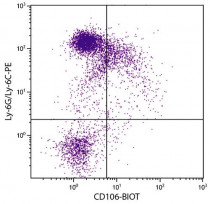ARG20803
anti-CD106 / VCAM1 antibody [M/K-2] (Biotin)
anti-CD106 / VCAM1 antibody [M/K-2] (Biotin) for Blocking,Flow cytometry,IHC-Frozen sections,Western blot and Mouse
Overview
| Product Description | Biotin-conjugated Rat Monoclonal antibody [M/K-2] recognizes CD106 / VCAM1 |
|---|---|
| Tested Reactivity | Ms |
| Tested Application | BL, FACS, IHC-Fr, WB |
| Specificity | Mouse CD106. The clone MK-2 has been used in transplant studies to suppress cardiac rejection and induce long-term cardiac graft survival. The M/K-2 monoclonal antibody immunoprecipitates a peptide that gives a single band on SDS-PAGE gels with an apparent MW of ~100 kDa under reducing conditions and 92 kDa under non-reducing conditions. |
| Host | Rat |
| Clonality | Monoclonal |
| Clone | M/K-2 |
| Isotype | IgG1, kappa |
| Target Name | CD106 / VCAM1 |
| Antigen Species | Mouse |
| Immunogen | BALB/3T3 and +/+2.4 cells |
| Conjugation | Biotin |
| Alternate Names | CD106; INCAM-100; Vascular cell adhesion protein 1; VCAM-1; CD antigen CD106; V-CAM 1 |
Application Instructions
| Application Suggestion |
|
||||||||||
|---|---|---|---|---|---|---|---|---|---|---|---|
| Application Note | * The dilutions indicate recommended starting dilutions and the optimal dilutions or concentrations should be determined by the scientist. |
Properties
| Form | Liquid |
|---|---|
| Buffer | PBS and 0.1% Sodium azide. |
| Preservative | 0.1% Sodium azide |
| Concentration | 0.5 mg/ml |
| Storage Instruction | Aliquot and store in the dark at 2-8°C. Keep protected from prolonged exposure to light. Avoid repeated freeze/thaw cycles. Suggest spin the vial prior to opening. The antibody solution should be gently mixed before use. |
| Note | For laboratory research only, not for drug, diagnostic or other use. |
Bioinformation
| Database Links | |
|---|---|
| Gene Symbol | VCAM1 |
| Gene Full Name | vascular cell adhesion molecule 1 |
| Background | This gene is a member of the Ig superfamily and encodes a cell surface sialoglycoprotein expressed by cytokine-activated endothelium. This type I membrane protein mediates leukocyte-endothelial cell adhesion and signal transduction, and may play a role in the development of artherosclerosis and rheumatoid arthritis. Three alternatively spliced transcripts encoding different isoforms have been described for this gene. [provided by RefSeq, Dec 2010] |
| Function | Important in cell-cell recognition. Appears to function in leukocyte-endothelial cell adhesion. Interacts with integrin alpha-4/beta-1 (ITGA4/ITGB1) on leukocytes, and mediates both adhesion and signal transduction. The VCAM1/ITGA4/ITGB1 interaction may play a pathophysiologic role both in immune responses and in leukocyte emigration to sites of inflammation. [UniProt] |
| Calculated MW | 81 kDa |
| PTM | Sialoglycoprotein. |
Images (1) Click the Picture to Zoom In
-
ARG20803 anti-CD106 / VCAM1 antibody [M/K-2] (Biotin) FACS image
Flow Cytometry: BALB/c Mouse bone marrow cells stained with ARG20803 anti-CD106 / VCAM1 antibody [M/K-2] (Biotin) and ARG22106 anti-Ly6G + Ly6C antibody [RB6-8C5] (PE) followed by Streptavidin (FITC).






